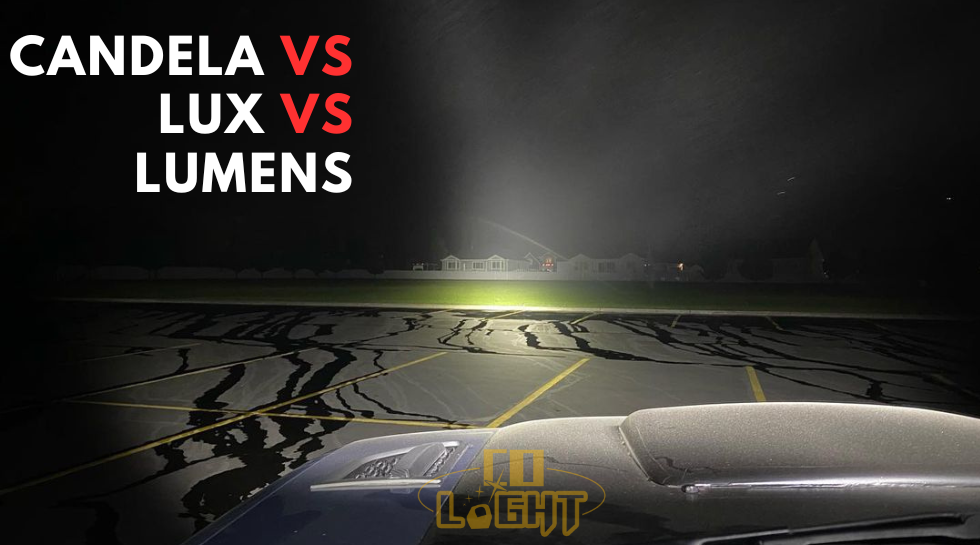Lighting plays a fundamental role in our lives, from brightening up our homes to guiding us safely on the road. Yet, have you ever wondered how we measure and quantify light? This is where lumens, lux, and candela come into the spotlight.
This happens often. When you're picking out a light bulb or headlight for your car, one lamp description says lumens, another says lux, and the last one says candela. You have to wonder why no one uses the same system to measure these things and can make best guesses about other car lights. In short, they are all independent standards for measuring different lighting effects.
Whether you're a lighting enthusiast or someone simply curious about the science behind light, this blog will tell you what Lumens, Lux, and Candela are and the differences between them.
Lumens
Lumen is a unit used to measure the total light output or radiant power of a light source, representing the total amount of visible light emitted by the source. It is used to describe the brightness of light. This figure is typically provided by the manufacturer of the LED chip itself, such as Cree, Philips, or Osram. The lumen rating is merely a measurement of the raw potential of light and does not take into account any other factors in the design and engineering of light, such as the geometry and size of reflectors, the clarity of lenses, and various other factors. For example, two lights with the same lumen output may have differences in electrical efficiency, lens clarity, and the size and geometry of reflectors, resulting in different outputs.
Lux
Lux is a unit used to measure the illuminance on a specific area. It represents the intensity of light from a light source that falls on a surface at a certain distance, typically used to describe the level of illumination. Lux is at the opposite end of the spectrum from lumens and refers to the actual amount of light reaching a surface from a specified distance. Lux is often measured within one square meter on a wall at a distance of 10 meters. For instance, take a single light source and project its light onto a wall while ensuring a distance of 10 meters between them. Then, measure the lux output within one square meter on that wall.
As an example, consider a spotlight with a very concentrated beam, having a very bright focal point. This would result in a high lux value, indicating that the light is projected over a long distance. Conversely, lights like floodlights, which have a wider beam angle, may have lower lux values, not because their light quality is poorer but because their design purpose is to spread light over a wider area. Lux is, therefore, an excellent method for measuring light quality.
Candela
Candela (Cd) is a unit used to measure the intensity of a light source in a specific direction, typically used to describe the intensity of spotlights or directional light sources.
The key distinction between lumens and candela lies in that lumens represent the total visible light output, while candela represents the output or intensity of light in a particular direction. An interesting fact about candela is that it is also referred to as candlepower, and an actual candle has a very appropriate candela rating.
Comparison
1. If two light sources have the same lumen value but one light source has a higher candela value, it means that the light source has a higher intensity of light in a specific direction. This can lead to the following scenarios:
-
Stronger Spotlight: A light source with a higher candela value can better focus the light, creating a more intense spotlight effect. This is very useful in applications that require directional or long-distance illumination, such as searchlights or flashlights.
-
High-Contrast Lighting: Light sources with high candela values can produce a more intense beam of light, creating higher contrast between objects or areas and their surrounding environment. This is crucial for applications that require highlighting specific areas or objects, such as stage lighting or outdoor billboard illumination.
It's important to note that the candela value only describes the intensity of the light source in a specific direction and does not consider the coverage area or lighting uniformity. Therefore, when selecting a light source, you need to consider both lumen and candela values to ensure they meet the lighting requirements of your specific application.
2. If two light sources have the same lumen and candela values but one light source has a higher lux value, it means that the light source produces a higher illuminance at a certain distance. In specific situations:
-
Brighter Illumination: A higher lux value indicates that the light is more intense and can illuminate an area more brightly at the same distance.
-
More Uniform Illumination: If two light sources have the same lumen and candela values but one has a higher lux value, it may provide more uniform illumination. This means that the light distribution within the illuminated area is more consistent, avoiding uneven lighting.
-
Higher Illuminance Level: If you need to achieve a higher level of illumination in a specific area, a light source with a higher lux value may be a better choice because it can provide more intense illumination.
It's worth noting that the lux value depends on the distance from the light source. Therefore, when comparing the lux values of two light sources, make sure to consider their performance at the same distance. Lux is an important parameter for evaluating illuminance and can help you choose the right light source for your specific lighting needs.
A good way to remember the differences between terms is:
- Lumens are how much light is given off
- Lux is how bright your surface will be
- Candela measures the visible intensity from the light source
Therefore, understanding all three of these terms is very useful as they help us quantify the total light output. When you need to purchase off-road lights, it will assist you in analyzing the performance of the lights. If you have more ideas, please feel free to share them with us!



